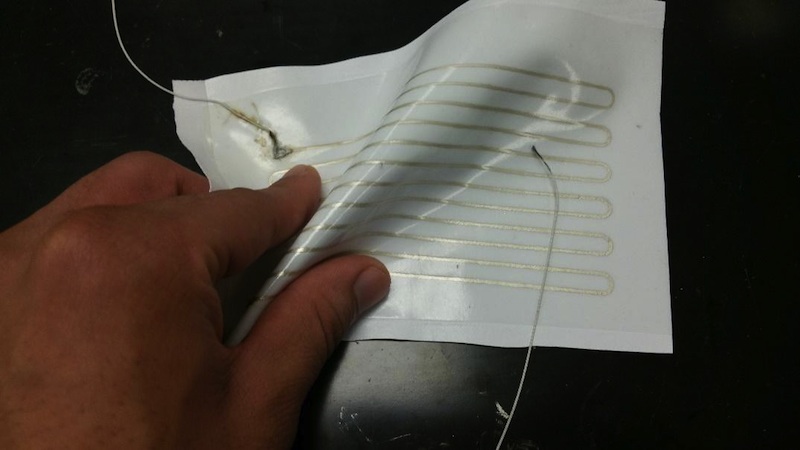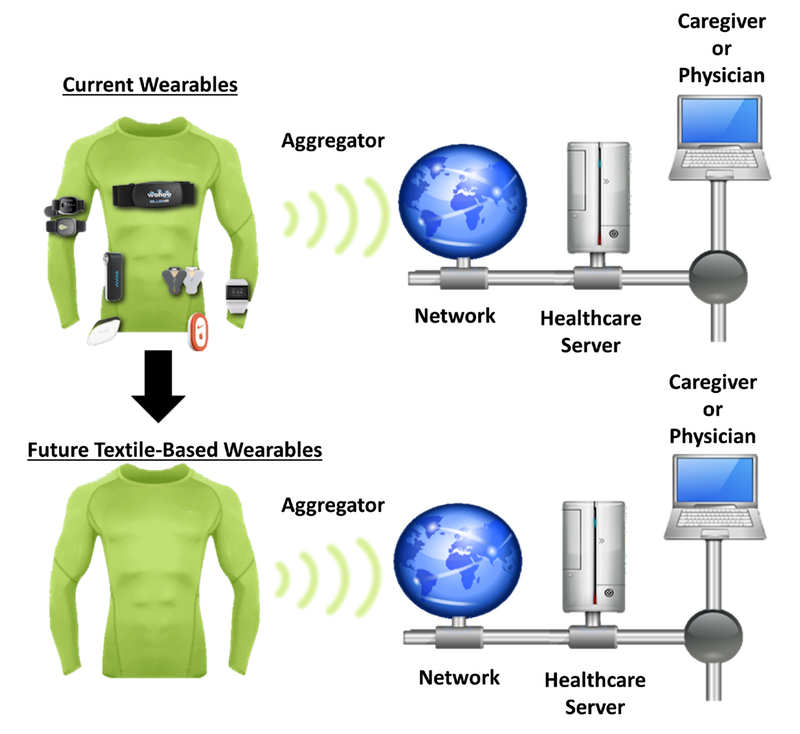Nearly all new cars are computerized in some fashion. Cellphones, of course, are now more than just appliances for calls, but rather devices that facilitate and generate 21st-century communication, be that through social media, email, news, or text messaging. Industries that were based on the physical production and palpable digestion of information and data, like newspapers and libraries, are now digitized and channeled through electronics. As the world becomes more and more linked together through these networks, how do industries that remain relatively unchanged in their product manufacturing and product use adapt to the computer age?
For Raj Bhakta, a PhD student at North Carolina State University, textiles may provide the next conduit for a new form of technology through data processing and exchange with their surrounding environment. Bhakta does research on smart clothing and electronic textiles, where he studies the effects of fiber optics and electronics that are embedded or printed onto textiles. Such “smart” textiles have a range of promising uses: gathering data of vital signs for hospital patients, monitoring individuals working with hazardous materials, and even re-imagining fashion and apparel as living and dynamic extensions of the body.
In addition, Bhakta is scheduled to partake on a panel at Moogfest, which commences this Thursday, May 18th. The four-day conference, named after analog synthesizer-pioneer Robert Moog, seeks to project the voices of scientists, engineers and modern thinkers by day, and offer a diverse and experimental roster of musicians and artists by night, throughout Durham, North Carolina. Berlin Art Link got the chance to speak with Bhakta on his research and the current state of electronic textiles as he prepares for the festival.
Liam Casey: Smart clothing and electronic textiles are relatively new technologies that are just beginning to broach the surface. How did you get interested in this field?
Raj Bhakta: I actually never knew there was something like ‘smart textiles’ or ‘electronic textiles’ until I came to NC State. I have a physics and nuclear engineering background so initially came to study that at NC State. During my short time in nuclear engineering, I was coming up with ideas for self-powered wearable devices for radiation monitoring targeted for radiologists, patients, nuclear workers, and eventually for space travel. That idea spurred me on a path to find a new place where I can exercise my inventorship, creativity, and entrepreneurship through the lens of science and engineering. I found myself in the ASSIST Self-Powered Wearables Research Center and NC State College of Textiles. I instantly fell in love with the idea of integrating electronics into textiles, given the immense potential for changing the function and value of a material that really hasn’t changed that much in centuries. If I could make sensors cheap enough on textiles that someone in the emerging world can afford and use, that can spur humanity towards a path of preventative medicine. The vision behind this was immensely motivating and I truly believe there is a lot of value in creating not only new technology but new art through the fusion of electronics and textiles. A good example is the ‘Pulse’ dress that our research group worked on which pulses LEDs intertwined into a formal dress based on your heart rate.
I like to question: what if your clothing could change colors based on your emotions? What if your clothing constantly tracks your physiology and can tell you if you’re going to be sick soon? What if you could 3D print your clothing with your own branding? Heck, what if you could change your clothing like you change your software? I believe this is a future I want to be a part of and it excites me that I have the opportunity to contribute to some of this exponential technological change!

Raj Bhakta, flexible direct-write printed heater // Courtesy of Raj Bhakta
LC: At North Carolina State University, you are a graduate research assistant at Nano-Extended Textiles (NEXT), which seeks to integrate electronics into fibers and fabrics. With your work, do you envision wearable technologies and smart textiles to be easily commodified and to revolutionize every aspect of textile application? Or more as niche technology geared towards health markets and/or innovative fashion?
RB: This is a great question because it hits on the fundamental operational principles of the textiles and wearables markets. Both are becoming increasingly commodified, as you can see with Fitbit and the other wrist-worn devices being released into the market. This is great from a consumer-facing side where you as a consumer have many choices and brands to buy from. However, with all sensors technologies, commodification is the eventual route and the only differentiating value proposition becomes the actionable insights you can deliver from the data but eventually that can become commodified as well. I liken the evolution of the wearables industry to that of the apparel industry, where there are many brands with the same basic offerings (clothing), just packaged in either a different look or different user experience.
Textiles industry is already commodified in that respect with it being a low-margin industry where profits are made up on volume sales (in most cases). As the technology and manufacturing costs of making electronic and smart textile products comes down, the scale will increase. A lot of big brands like Nike, UnderArmour, and Adidas are waiting for this to happen. So it’s just a matter of time till we’ll be able to buy a compression shirt that looks and feels like a compression shirt but has sensors in it like your Fitbit does, all at an affordable price range (less than $100).
To your point, I envision a commodification when it reaches the mass consumer for sports applications. In the interim, I see a more compelling value proposition for healthcare applications where there’s an inherent need to solve a problem. Fitness products are more of a ‘nice-to-have’, which is why you see many companies come and go in the wearable technology space. However, there are macroeconomic trends taking place right now that serve to well-position the wearable technology and eventually electronic textiles space so I’m pretty optimistic that this is going to happen. The smartphone was around before Apple released the iphone. After the iphone was released the smartphone market exponentially increased in value. This is how technology works and you will see it time and time again happening in various spaces.
I also believe there’s a huge unmet opportunity in the fashion space. I’ve talked to many fashion designers and there are mixed opinions about how technology can be used to augment or disrupt the traditional notion of fashion. People get scared when they think of ‘clothing that changes color based on their emotion’ but I believe something like that is just another natural evolution in allowing clothing to facilitate another layer of social interaction. To think of us posting 140 character versions of our thoughts (Twitter), creating fluid collages of our life moments (Instagram), or of sending real-time pictures and 8 second videos that get deleted, would have been crazy 20 years ago. In the same respect, it sounds crazy to think that we will be creating new paradigms of fashion when both merge, but the technology is definitely there and there’s a small community of early adopters and designers/engineers that are exploring the possibilities. And if you see what’s happened with the fashion retail space with the ‘retail apocalypse’, it’s only going to become exacerbated as consumption of clothing shifts to other areas of the greater fashion industry, especially in terms of lifestyle experiences.

Raj Bhakta, relationship between the textile based wearable device and the data infrastructure for our internet-of-things application // Courtesy of Raj Bhakta
LC: NEXT has outlined on its website that one of its core themes is “Textile-inspired electronic devices”, which includes early designs in “human energy harvesting” and “physiological sending”. Obviously there seems to be much potential and good that can come of electronic textiles, such as monitoring and compiling data of vital signs. However, do you worry—particularly with phrases such as “human energy harvesting”—that these technologies will have negative effects on the physical anatomy of bodies, or create a dependency between the technology and the human body it aims to serve?
RB: Great question – I’m glad you brought this up because this is something we should ask ourselves for every new technology we create. As an entrepreneurially- and philosophically-minded technologist, I definitely believe that technology in and of itself is inherently a neutral entity. It is a tool and like any tool humans have the power to project good or bad onto them. As such, given the way these technologies are made, there isn’t that big of a worry when it comes to the interaction of such electronics to our bodies. The radiation from our smartphones and other wearable devices is much, much lower than that of ambient radiation (we actually get hit by cosmic radiation everyday!). Fun fact: A banana has more ‘harmful’ radiation coming from it because of the potassium-40 atoms in it than your smartphone.
As for ‘human energy harvesting’, that essentially just means that we try to take the heat our bodies emit or the kinetic energy we exert from our daily activities and try to harvest them to power our electronics. Think of putting on a shirt that can be self-powered from your body heat and your daily walking alone. That’s the vision behind our research at the ASSIST research center. So in relation to the negative effects on our bodies, with the technologies we create on a textile platform there won’t be any foreseeable negative effects to the human anatomy. As for dependency to technology, we seek to create passive technologies that can monitor physiology in an unobtrusive manner so that the user just has to put the shirt on and it works. This is challenging but the positive implications it has are far-reaching and exciting.
LC: A New York Times article addressed the growing concerns regarding electronic textiles’ effect on the environment after said garments or items have been used and discarded. Have you and your team researched the possible recyclable faculties of these technologies?
RB: I’m glad you brought up this point. This is one of the biggest issues facing all electronics at the moment. How do we reliably dispose of our electronics given that we buy so many electronics nowadays? As the market for electronic textiles matures, the issue of disposability becomes a priority. A lot of metals like silver will be used to provide the electrical properties for these textiles. At the moment, we already have a big problem of textile waste with most clothing ending up in landfills. This is something that the industry is thinking of at the moment but there aren’t complete strategies developed to solve this problem. As a researcher, I am definitely thinking about this and know what sorts of material developments will be needed to come up with a recycling strategy for such electronic textiles. A solution to this problem will take a paradigm shift in technology, supply chain, and consumer behavior for this to happen.
One approach would be to create modular textile designs which allow for the electronic portions to be removed in a modular fashion. Modular textile design can be leveraged to design such smart garments from the beginning. An enabling feature that can allow this to happen is to use innovative business models that allow for the value of the smart garment to come from the actionable insights that the health data creates. Then, when one is finished with the smart garment, it is returned to the manufacturer for recycling all free of cost because the lifetime value offered to the consumer is high due to the rich data it creates. Think of how Patagonia garments can be returned for recycling or repair.
LC: You are participating and moderating a panel at the upcoming Moogfest in Durham, North Carolina called ‘Textiles as a Second Skin’. What are you most looking forward to in discussing smart textiles in a public forum?
RB: I am looking forward to discussing the greater change or rather disruption of current paradigms of fashion and textiles through the lens of technology. I’m going to be coming into this discussion with a transhumanist and philosophical perspective about how clothing 2.0 will look, feel, and be used. Till now, we’ve used textiles as a second skin. As technology improves exponentially, we will be able to change the definition of what our clothing will be able to do. Imagine if your clothing could change its function and design based on your changing thoughts just like your Facebook timeline changes? Imagine if you were able to create your own brand, treating your clothing as a projection of your changing identity, just like social media allows us to do? What if your clothing could be synced to be a living billboard for projecting your thoughts? Think of the potential for protests and uniting for a cause. At the push of a button, you can sync the same message and be instantly connected to something just like you ‘like’ something on social media. This bridge from clothing to technology is something that interests me deeply and I believe will become a reality in the next 10 – 20 years.
Exhibition Info
MOOGFEST
Raj Bhakta: ‘Textiles as a Second Skin’
Talk: May 21, 2017; 3PM EST
Live stream online: moogfest2017.sched.com
Durham, NC




















